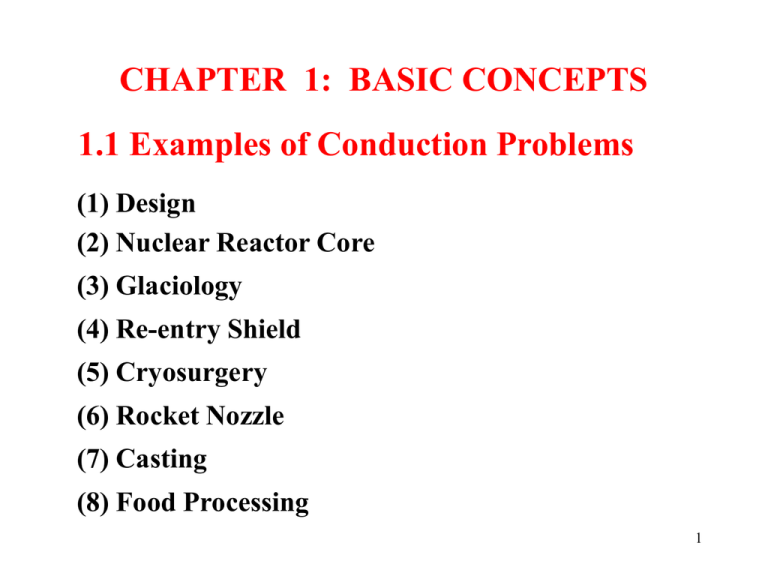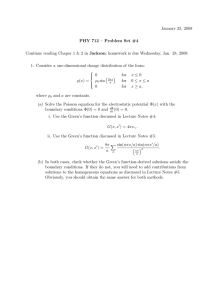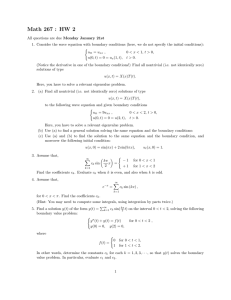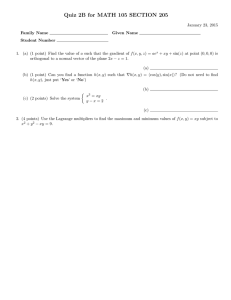CHAPTER 1: BASIC CONCEPTS 1.1 Examples of Conduction Problems
advertisement

CHAPTER 1: BASIC CONCEPTS 1.1 Examples of Conduction Problems (1) Design (2) Nuclear Reactor Core (3) Glaciology (4) Re-entry Shield (5) Cryosurgery (6) Rocket Nozzle (7) Casting (8) Food Processing 1 1.2 Focal Point in Conduction Heat Transfer Determination of the temperature distribution in a region 1.3 Fourier's Law of Conduction A(Tsi Tso ) qx L A(Tsi Tso ) (1.1) qx k L k = thermal conductivity Tso Tsi A qx dx 0 L x Fig.1.1 2 Apply (1.1) to an element dx T ( x ) T ( x dx ) T ( x dx ) T ( x ) q x kA kA dx dx dT q x kA dx (1.2) • Definition: heat flux qx qx qx A (1.3) dT qx k dx (1.4) 3 For 3-D: T T T (1.5) qx k , qy k , qz k x y z 1.4 Conservation of Energy: Differential Formulation of the Heat Conduction Equation in Rectangular Coordinates y Consider: • Uniform velocity • Volumetric energy generation q x z Fig. 1.2 4 Conservation of energy for element: Rate of energy added + Rate of energy generated – Rate of energy removed = Rate of energy change within element E in E g E out E (1.6) Express each term in eq. (1.6) in terms of the dependent variable T. Assumptions: (1) Negligible radiation (2) Negligible work done due to surface stress. 5 ˆ hˆ V h dy dxdz y q qy y dy dxdz y qx dydz dy q qx x dx dydz x dx Uhˆ dydz qy dxdz ˆ hˆ U h dx dydz x dy dx Vhˆ dxdz (b) (a) Figure 1.3 E in qx dydz qy dxdz qzdxdy Uhˆ dydz Vhˆ dxdz Whˆ dxdy (a) 6 E g qdxdydz E out (b) qy qx qx dx dydz qy dy dxdz x y ˆ hˆ qz qz dz dxdy U h dx dydz z x ˆ hˆ ˆ hˆ V h dy dxdz W h dz dxdy y z (c) U, V and W are constant since material motion is uniform. 7 Energy change within element E uˆ E dxdydz t (d) Substituting (a) - (d) into eq. (1.6) qx qy qz hˆ hˆ hˆ U V W x y z x y z uˆ (e) q t Enthalpy ĥ ˆh uˆ P (f) 8 (f) into (e) ˆ ˆ ˆ hˆ qx qy qz h h h q U V W x y z t x y z (g) Enthalpy change for constant P d hˆ cp dT (h) Eq. (1.5) and (h) into (g) T T T k k k q x x y y z z (1.7) T T T T c p U V W x y z t 9 Stationary material, constant k 2T 2T 2T q T 2 2 2 x c t y z p (1.8) = thermal diffusivity k c p (1.9) 1.5 The Heat Conduction Equation in Cylindrical and Spherical Coordinates Assumptions: (1) Constant k, (2) Constant and (3) No dissipation 10 z z (r,z,) • y (r,,) r • x x y r (a) cylindrical (b) spherical Fig. 1.4 Cylindrical Coordinates (r,,z) 1 T 1 2T 2T q 2 r 2 2 z c p r r r r (1.10) T V T T T Vr Vz r r z t Assume: (4) Stationary material 1 T 1 2T 2T q T 2 r 2 2 z c p t r r r r (1.11) Spherical Coordinates (r,,) 1 2 T 1 T 1 2T sin 2 2 2 r 2 2 r sin r r r r sin V T q T T V T Vr c p t r r r sin (1.12) For stationary material 1 2 T 1 T 1 2T 2 r 2 sin 2 2 2 r sin r r r r sin q T c p t (1.13) 1.6 Boundary Conditions Boundary conditions are mathematical equations describing what takes place physically at a boundary 13 An initial condition describes the temperature distribution at time t = 0 1.6.1 Surface Convection: Newton's Law of Cooling Energy interchange between a surface and a fluid moving over it qs Ts T qs hTs T (1.14) h = heat transfer coefficient 14 1.6.2 Surface Radiation: Stefan-Boltzmann Law The Stefan-Boltzmann law for an ideal surface called blackbody is qb Ts4 (1.15) qb blackbody radiation flux Ts surface temperature, absolute degrees Stefan-Boltzmann constant 8 5.67 10 W m K 2 4 (1.16) 15 Emissivity : qr qb (1.17) Combining (1.15) and (1.17) qr Ts4 (1.18) • Special case: small gray surface which is completely enclosed by a much larger surface qr 1A1 T14 T24 ( )1 = small surface ( )2 = large surface T = absolute temperature (1.19) 16 1.6.3 Examples of Boundary Conditions Typical boundary conditions are shown in Fig. 1.5 and Fig. 1.6 y insulation qo W To 00 L convection, h, T x Fig. 1.5 k1 k2 T1 T2 00 x Fig. 1.6 To write boundary conditions we must: • Select an origin • Select coordinate axes • Identify the physical conditions at the boundaries 17 y insulation qo W To 00 L convection, h, T x Fig. 1.5 (1) Specified temperature Along (0,y) the temperature is To T (0, y ) To (1.20) (2) Specified flux The heat flux along (L,y) is given as qo T ( L, y ) qo k x (1.21) 18 (3) Convection Heat is exchanged at (x,0) by convection with a fluid at temperature T. Conservation of energy, Newton’s law and Fourier’s law: T ( x ,0) hT T x ,0 k y (1.22) (4) Insulated Boundary Boundary (x,W) is thermally insulated. Fourier’s law: T x ,W 0 y (1.23) 19 (5) Interface + For a perfect interface contact, continuity of temperature T1 0, y T2 0, y k1 1 T 1 (1.24) k2 T2 2 0 q i Equality of flux gives T1 0, y T2 0, y k1 k2 x x Fig. 1.7 (1.25) 20 (6) Interface with a heat source Examples: (1) An electrical heating element which is sandwiched between two materials (2) An interface with frictional heat due to relative motion Boundary conditions: Continuity of temperature: For perfect contact, eq. (1.31) applies. 21 Conservation of energy at the interface T1 0, y T2 0, y k1 qi k 2 x x (1.26) (7) Radiation Boundary (x,0) exchanges heat by radiation and convection. y Conservation of energy gives 0 qrad qcond qconv h, T x Tsur 22 Use Fourier, Newton, and Stefan-Boltzmann laws: hT T x ,0 4 Tsur T x ,0 T x ,0 k y (1.27) 4 1.7 Problem Solving Format Conduction problems lend themselves to a systematic solution procedure. (1) Observations • Read the problem statement very carefully. • Note essential facts and features: geometry, temperature, heat flow direction, symmetry, number of independent variables, etc. 23 • Identify characteristics that require special attention: variable properties, composite domain, non-linearity, radiation, phase change, etc. • Show a sketch (2) Origin and Coordinates • Select an origin and a coordinate system appropriate to the geometry under consideration. (3) Formulation • Express problem mathematically • Define all terms 24 • Assign units to all symbols • Proceed according to the following steps: (i) Assumptions Modeling the problem. List all assumptions. (ii) Governing Equations Select an appropriate heat equation. (iii) Boundary conditions Decide on the number of boundary conditions needed. Identify the physical nature of each boundary condition and express it mathematically. 25 (4) Solution • Examine equation to be solved. Select a method of solution. • Apply boundary conditions. (5) Checking • Check each step of the analysis as you proceed • Apply dimensional checks and examine limiting cases (6) Computations • Execute the necessary computations and calculations to generate the desired numerical results. 26 (7) Comments 1.8 Units The basic units in the SI system are Length (L): meter (m) Time (t): second (s) Mass (m): kilogram (kg) Temperature ( T): kelvin (K) Temperature on the Celsius scale is related to the Kelvin scale by (1.28) T(oC) = T(K) - 273.15 27 Units of other derived quantities: • Force: Measured in newtons (N). One newton is the force needed to accelerate a mass of one kilogram one meter per second per second. N = kg • m /s 2 • Energy: Measured in joules (J). One joule is the energy associated with a force of one newton moving a distance of one meter. 2 2 J = N. m = kg • m /s 28 • Power: Measured in watts (W). One watt is the energy rate of one joule per second. W = J/s = N. m/s = kg • m2 /s 3 29



